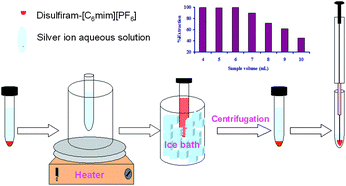Microextraction and preconcentration of Ag+ by using temperature-controlled ionic liquid-based dispersive liquid-phase microextraction (TCIL-DLPME) method is reported. It was found that tetraethylthiuram disulfide (disulfiram) dissolved in 1-hexyl-3-methylimidazolium hexaflorophosphate, [C6mim][PF6] was useful as extracting media. Graphite furnace atomic absorption spectroscopy was used to quantify Ag+. To improve extraction efficiency, different experimental factors, such as volume of ionic liquid phase, pH and volume of aqueous solution, cooling and centrifugation periods, and dissolving temperature were investigated. The calibration curve was linear in the concentration range of 6.0–100.0 ng l−1 of Ag+. Relative standard deviation (n = 7), detection limit, and preconcentration factor for determination of Ag+ were found to be 4.5%, 5.2 ng l−1, and 120, respectively. The method was successfully applied for determination of Ag+ in drinking water and hair samples. Percent recoveries for solutions containing Ag+ indicated that chemical interferences by selected anions (NO3−, Cl−, I−, Br− and citrate) or cations (Ni2+, Cu2+, Mg2+, Zn2+, Pb2+, Ca2+, Co2+, Hg2+, Na+ and Mn2+) in solution were minimal or non-existent.


 Please wait while we load your content...
Please wait while we load your content...